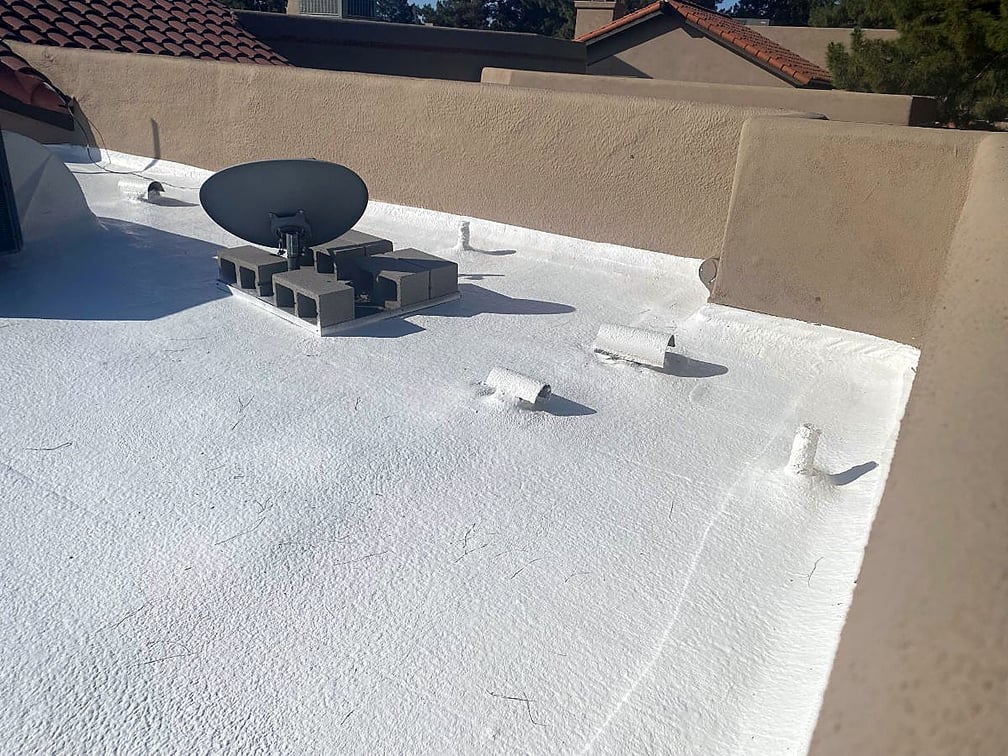Why do I need to Recoat my roof?
Recoating a foam roof is an important part of regular maintenance for foam roofing systems in Arizona. There are several reasons why you may need to recoat your foam roof:
- Protect against weathering: Foam roofs are exposed to intense UV radiation, extreme heat, and occasional monsoon rains in Arizona, which can cause them to deteriorate more quickly than in other parts of the country. Recoating the roof can help to protect it from weathering and extend its lifespan.
- Prevent leaks: Over time, the foam roof may develop small cracks or areas of damage that can lead to leaks. Recoating the roof can help to seal these areas and prevent water from penetrating the roof and causing damage to the underlying structure.
- Improve energy efficiency: A fresh coating on the foam roof can help to reflect sunlight and reduce heat absorption, which can help to improve the energy efficiency of the building and reduce cooling costs.
- Extend the life of the roof: Regular maintenance, including recoating, can help to extend the life of the foam roof and minimize the need for costly repairs or replacements.

What is the best time of year to recoat a foam roof?
The best time of year to recoat a foam roof in Arizona is during the cooler months, typically from September to November, and February to May, depending on the temperatures and moisture in the air. This is because high temperatures and intense UV radiation can affect the application and curing of the coating, which can compromise the quality and durability of the roof.
During the cooler months, the weather is typically more mild and consistent, which can help to ensure optimal conditions for the application and curing of the coating. Additionally, applying the coating during the cooler months can help to prepare the roof for the upcoming summer months, which are typically the most challenging for foam roofs in Arizona.
It is important to work with a licensed roofing contractor who can assess the condition of your roof and recommend the best time for recoating based on your specific situation. They can also ensure that the appropriate type of coating is used and that the roof is properly maintained to extend its lifespan and minimize the need for repairs or replacements.
What is the Elastomeric Coating used to recoat foam roofs?
An elastomeric coating for foam roofs is a type of coating that is specifically designed for use on foam roofing systems. It is a high-performance, liquid-applied coating that forms a seamless, durable, and flexible membrane over the foam roof.
Elastomeric coatings are made from a blend of synthetic resins, fillers, and pigments, which give them excellent adhesion, water resistance, and UV stability. They can be applied to new or existing foam roofs to protect them from the damaging effects of the sun, wind, rain, and other environmental factors.
Some of the benefits of using an elastomeric coating for foam roofs include:
- Waterproofing: Elastomeric coatings create a seamless barrier that prevents water from penetrating the foam roof and causing damage.
- UV protection: Elastomeric coatings are designed to resist UV radiation, which can cause the foam roof to deteriorate and become brittle over time.
- Energy efficiency: Elastomeric coatings can help to improve the energy efficiency of the foam roof by reflecting sunlight and reducing heat absorption.
- Flexibility: Elastomeric coatings are flexible and can expand and contract with the foam roof, which helps to prevent cracking and peeling.
- Low maintenance: Elastomeric coatings require minimal maintenance and can help to extend the lifespan of the foam roof.
Overall, using an elastomeric coating for foam roofs can be an effective way to protect and extend the life of your foam roofing system, while also improving its energy efficiency and reducing maintenance costs over time.